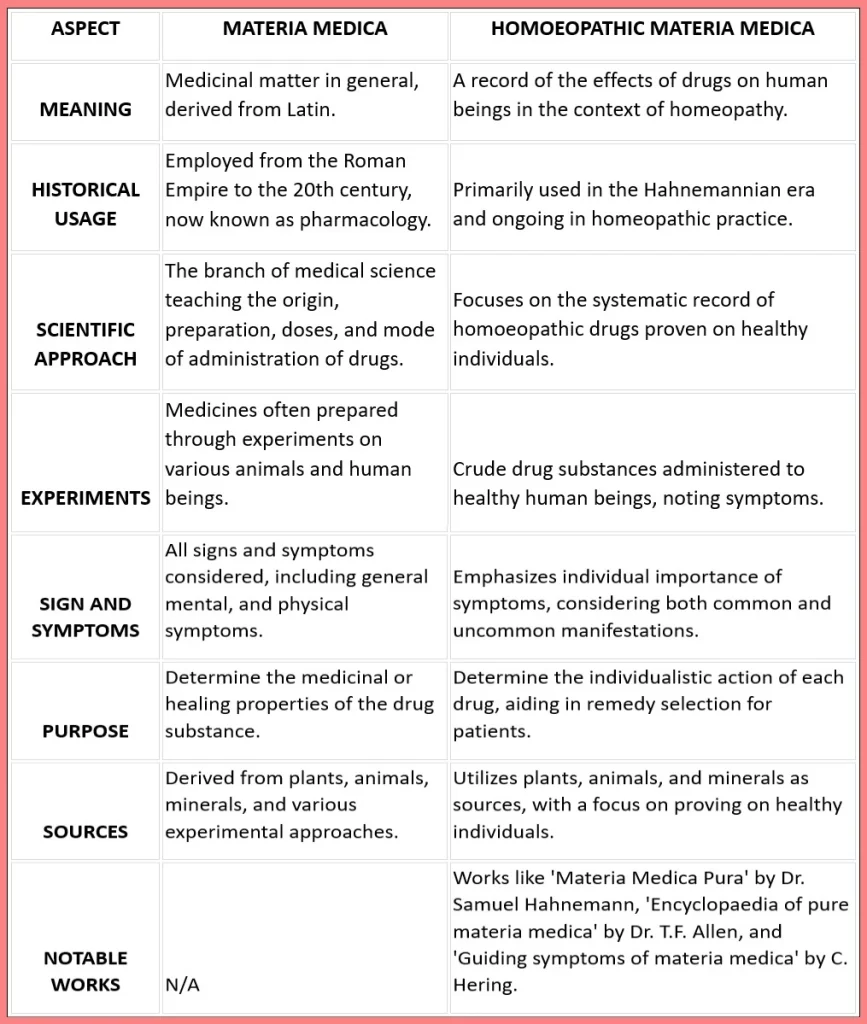
Materia Medica, a term originated from Latin, has been an integral part of medical practice since the Roman Empire.
Read the History of medicine by following the link.
However, its significance took a notable turn during the Hahnemannian era, particularly in the field of homeopathy.
In this blog post, we will delve into the meaning, history, scientific approach, experiments, and sources associated with Materia Medica, drawing a distinction between general Materia Medica and its homeopathic counterpart.
WHAT IS MATERIA MEDICA?
Meaning | Derived from Latin, it means medicinal matter. In general terms, it refers to the body of collected knowledge about the therapeutic properties of substances used for healing. |
History | Used from the Roman Empire until the 20th century, now known as pharmacology. |
HOMOEOPATHIC MATERIA MEDICA: A DEEPER DIVE
Meaning | In homeopathy, it can be defined as a record book of the effects of drugs on human beings. It is the systematic record of homoeopathic drugs proven on healthy individuals. |
Scientific Approach | Branch of medical science teaching the origin, preparation, doses, and mode of administration of drugs. |
Experiments | Crude drug substances were administered to healthy human beings of both sexes and different ages. |
Sign and Symptoms | Noted all signs and symptoms, considering general mental, and physical symptoms, emphasizing their individual importance. |
Purpose | Determined the medicinal or healing properties of the drug substance. Focused on establishing the individualistic action of each drug. |
What is the difference between materia medica and homoeopathic materia medica?

FREQUENTLY ASKED QUESTIONS (FAQS)
Q1: What is the origin of the term Materia Medica?
A1: The term originated from Latin, signifying medicinal matter, and has been used since the Roman Empire.
Q2: How does homoeopathic Materia Medica differ from the general concept?
A2: Homoeopathic Materia Medica is a specialized record of the effects of drugs on healthy individuals in homeopathy, with a focus on individualistic drug actions.
Q3: What is the purpose of Materia Medica in homeopathy?
A3: The main purpose is to determine the individualistic action of each drug substance, aiding in the selection of the most suitable remedy for a patient.
Q4: How were experiments conducted in the development of Materia Medica?
A4: In homeopathy, crude drug substances were administered to healthy individuals of both sexes and different ages, noting all signs and symptoms.
Q5: What are the primary sources of homoeopathic Materia Medica?
A5: Sources include plants, animals, and minerals. Pioneers like Dr. Samuel Hahnemann and Dr. T.F. Allen contributed through works like ‘Materia Medica Pura’ and ‘Encyclopaedia of pure materia medica.’
In conclusion, Materia Medica, both in general medicine and homeopathy, plays a vital role in understanding the therapeutic properties of substances. In homeopathy, it becomes a detailed record guiding practitioners in selecting remedies based on individualized symptoms and characteristics.













Leave a Reply